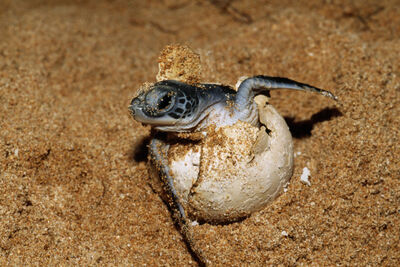Green sea turtles are known for their massive size, long migrations and green hue. However, they are full of surprises, from their ability to navigate thousands of miles using the Earth's magnetic field to their extraordinary nesting habits and the crucial role their plant-based diet plays in the marine ecosystem. If you're curious to discover more about these graceful giants, read on for our top ten green sea turtle facts…

Scientific name
Green sea turtles, scientifically known as chelonia mydas, derive their name from the Greek words chelonia, meaning tortoise and mydas, meaning wetness or swamp. Interestingly, the term green in their name doesn't refer to their shell, which is usually brown or olive, but rather to the greenish tint of their body fat, resulting from their plant-based diet.

Large size
Adult green sea turtles are among the largest sea turtle species, reaching lengths of 3 to 4ft and weighing between 300 and 350lbs, almost the same weight as a fully-grown male black bear. Their impressive size is complemented by their massive shells, which not only provide protection but also help them navigate and remain stable in the open ocean.

Diet
Another interesting fact about green sea turtles is that they differ from most other sea turtles as they primarily follow a herbivorous diet, feeding mainly on seagrasses and algae. Their grazing also plays an important role in supporting marine ecosystems, as it helps maintain the health of seagrass meadows, which provide essential habitats for many marine species.

Lifespan
Green sea turtles can live remarkably long lives, with a lifespan of 60 to 70 years in the wild. However, various threats often shorten their years. Young hatchlings are particularly vulnerable to natural predators like sharks and large fish, while adult turtles face significant dangers from human activities, including boat strikes, entanglement in fishing gear and habitat destruction.

Swimming ability
Green sea turtles are powerful swimmers, using their large, paddle-like front flippers to glide effortlessly through the water. Their streamlined bodies and strong flippers enable them to cover long distances in search of food or nesting sites, and while they may not be the fastest swimmers, they can reach up to 25 miles per hour in short bursts, especially when threatened, allowing them to navigate vast oceanic spaces easily.

Migration
Green sea turtles are renowned for their incredible long-distance migrations, travelling thousands of miles between their feeding grounds and nesting sites. Migrating from nutrient-rich seagrass beds along the U.S. coast to nesting beaches in the Caribbean or even from Australia to Indonesia. Their remarkable navigation abilities are thought to rely on the Earth's magnetic field, visual cues and other natural signs. Some research also suggests that certain locations along their migratory route may serve as geomagnetic landmarks, where the magnetic field has specific characteristics that turtles can detect and use for orientation.

Nesting sites
Our favourite green sea turtle fact is that female green sea turtles exhibit an incredible behaviour called natal homing. Guided by what seems like an innate GPS, they return to the exact beach where they were born to lay their eggs. This remarkable precision is essential for their reproduction, with some females returning to the same beach multiple times in a single nesting season to ensure their eggs are laid in a familiar and suitable environment, giving the next generation the best chances of survival.

Hatchling survival
Female green sea turtles lay between 100 and 200 eggs per clutch (a group of eggs laid in one nesting event). They nest at night - burying the eggs in deep sand nests to protect them from predators and extreme temperatures - and return multiple times to lay additional clutches in a season which is vital for the species' survival. After hatching, the young turtles make a desperate dash to the ocean, facing immediate threats from predators like birds, crabs and larger fish, meaning that only a tiny percentage of hatchlings survive to adulthood.

Sex determination
Green sea turtles exhibit temperature-dependent sex determination (TSD), meaning the temperature of the sand where their eggs incubate determines the hatchlings' sex. Warmer sand produces more females, while cooler sand produces more males. This natural process is now a concern due to climate change, as rising temperatures could lead to an overabundance of females, disrupting the balance for a stable and healthy population.

Conservation status
Green sea turtles are classified as endangered by the International Union for Conservation of Nature (IUCN). Habitat loss caused by coastal development and pollution reduces the availability of suitable nesting and feeding areas, while poaching for their meat, shells and eggs further depletes their numbers. To combat these challenges conservation efforts are focused on protecting nesting beaches, reducing bycatch and raising awareness about the need to safeguard this vital marine species.
If you enjoyed this blog, you may also enjoy Our Top Ten Angelfish Facts, Our Top Ten Pufferfish Facts or Our Top Ten Mola Mola Facts.
















